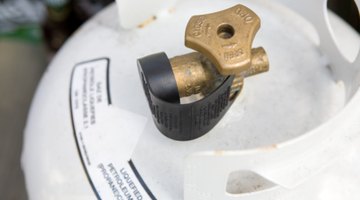How to Convert a Propane Tank for Compressed Air
Propane tanks can be found underneath barbecues all over the country, but they can also have another use. If you have an air compressor that you use for doing carpentry work, you may find that there isn't much capacity in the tank.

Things You Will Need
- Flathead screwdriver
- Ratcheting tie-down straps
- 2 by 4
- Large crescent wrench
- 6-foot section of steel tubing
- Hose
- Liquid soap
- Funnel
- 1 qt. rust primer
One way to change that is to add another tank, and the cheapest way to do that is to use a propane tank. Before you can do that though, you first have to convert the tank so that you can use it for compressed air.
-
Put the propane tank in an open area. Open the valve on the top of the propane tank by turning it counterclockwise. Let any gas expel out of the tank. Insert a flathead screwdriver into the fitting portion of the valve and depress the check valve in the center of the fitting to let out any excess gas that may be in the tank.
-
Secure the propane tank to one side of a 2 by 4 using the ratcheting tie-down straps. Wedge the 2 by 4 between an immovable object so that any force you exude on the tank will be stopped by the 2 by 4 and the immovable object.
-
Put the crescent wrench onto the hex-head on the top of the valve and then install the 6-foot stick of steel tubing over the handle of the crescent wrench to provide extra leverage. Turn the crescent wrench counterclockwise with the steel tubing until the valve on the top of the propane tank is removed.
-
Fill the propane tank with water from the hose and then let the water run to circulate the water through and out of the tank. Empty the water out of the tank and then fill the tank with hot water and some liquid soap. Shake the propane tank to mix the soap with the water and then empty out the tank. Rinse the tank one last time with the water from the hose. Turn the tank over to empty out any water in the system and then allow the tank to dry for several days.
-
Put a funnel into the hole at the top of the tank. Pour the rust primer into the funnel. Reinstall the propane valve loosely with your hands. Rotate the propane tank slowly end-over-end to mix the rust primer all over the inside of the tank. Remove the propane valve and drop the tank over the rust primer paint can to let any excess paint pour out. Allow the tank to dry for several days and then the tank will be ready to accept any fittings you can use for the air compressor.
Warning
Propane is flammable, so be sure not to smoke or have any ignition source near you while performing this process. If you have the ability to do so, it helps to pressure-test the tank. Fill the tank halfway with water and then attach a fitting on the top that's connected to an air compressor hose and a gauge. Fill the tank with compressed air and watch the pressure reading on the gauge. Make sure the pressure meets or exceeds what your air compressor is capable of before putting it into service.
References
Warnings
- Propane is flammable, so be sure not to smoke or have any ignition source near you while performing this process. If you have the ability to do so, it helps to pressure-test the tank. Fill the tank halfway with water and then attach a fitting on the top that's connected to an air compressor hose and a gauge. Fill the tank with compressed air and watch the pressure reading on the gauge. Make sure the pressure meets or exceeds what your air compressor is capable of before putting it into service.
Writer Bio
Russell Wood is a writer and photographer who attended Arizona State University. He has been building custom cars and trucks since 1994, including several cover vehicles. In 2000 Wood started a career as a writer, and since then he has dedicated his business to writing and photographing cars and trucks, as well as helping people learn more about how vehicles work.
Photo Credits
- Jupiterimages/Photos.com/Getty Images
- Jupiterimages/Photos.com/Getty Images
More Articles



